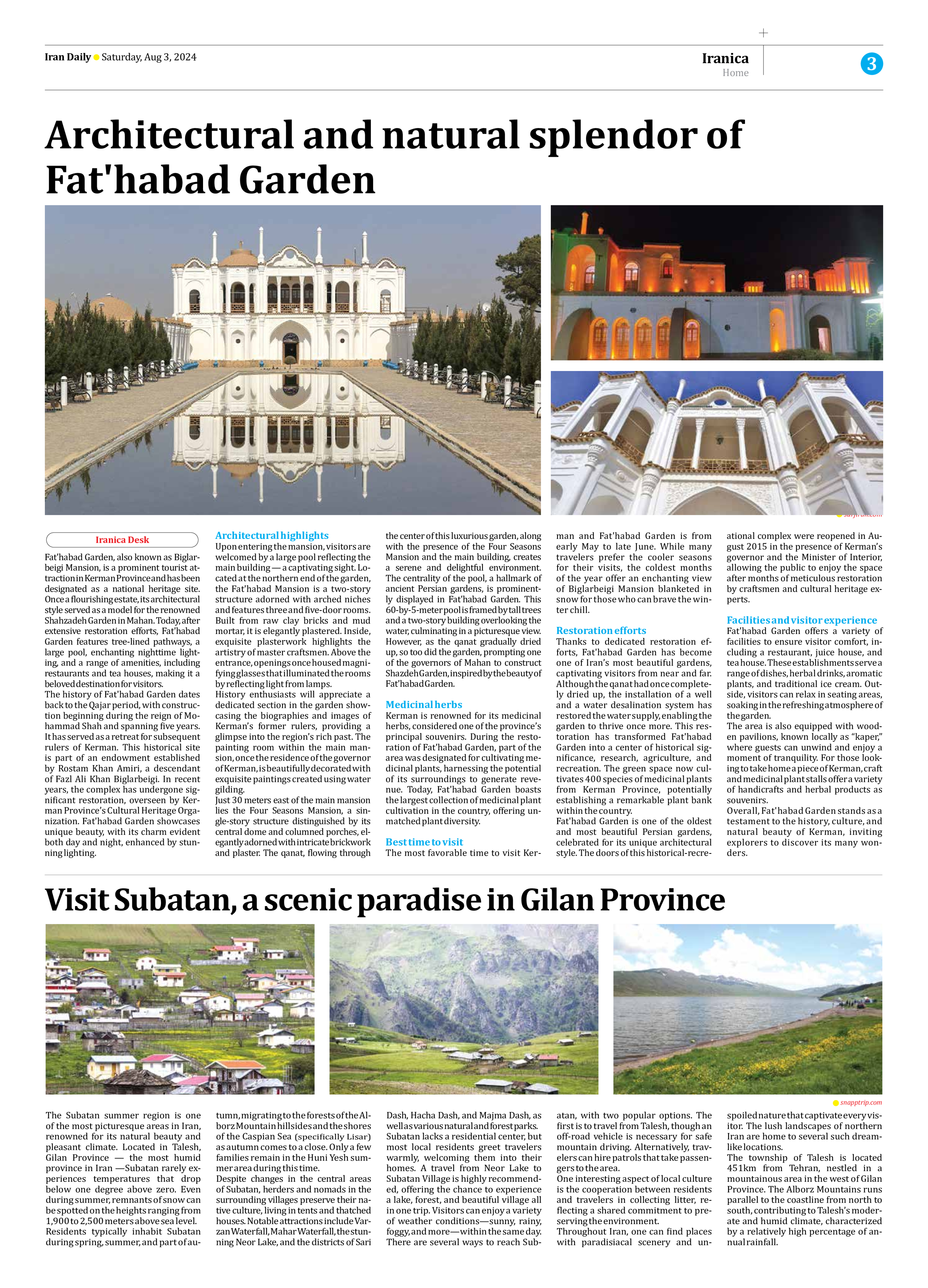
Architectural and natural splendor of Fat’habad Garden
Fat'habad Garden, also known as Biglarbeigi Mansion, is a prominent tourist attraction in Kerman Province and has been designated as a national heritage site. Once a flourishing estate, its architectural style served as a model for the renowned Shahzadeh Garden in Mahan. Today, after extensive restoration efforts, Fat'habad Garden features tree-lined pathways, a large pool, enchanting nighttime lighting, and a range of amenities, including restaurants and tea houses, making it a beloved destination for visitors.
The history of Fat'habad Garden dates back to the Qajar period, with construction beginning during the reign of Mohammad Shah and spanning five years. It has served as a retreat for subsequent rulers of Kerman. This historical site is part of an endowment established by Rostam Khan Amiri, a descendant of Fazl Ali Khan Biglarbeigi. In recent years, the complex has undergone significant restoration, overseen by Kerman Province’s Cultural Heritage Organization. Fat'habad Garden showcases unique beauty, with its charm evident both day and night, enhanced by stunning lighting.
Architectural highlights
Upon entering the mansion, visitors are welcomed by a large pool reflecting the main building — a captivating sight. Located at the northern end of the garden, the Fat'habad Mansion is a two-story structure adorned with arched niches and features three and five-door rooms. Built from raw clay bricks and mud mortar, it is elegantly plastered. Inside, exquisite plasterwork highlights the artistry of master craftsmen. Above the entrance, openings once housed magnifying glasses that illuminated the rooms by reflecting light from lamps.
History enthusiasts will appreciate a dedicated section in the garden showcasing the biographies and images of Kerman’s former rulers, providing a glimpse into the region’s rich past. The painting room within the main mansion, once the residence of the governor of Kerman, is beautifully decorated with exquisite paintings created using water gilding.
Just 30 meters east of the main mansion lies the Four Seasons Mansion, a single-story structure distinguished by its central dome and columned porches, elegantly adorned with intricate brickwork and plaster. The qanat, flowing through the center of this luxurious garden, along with the presence of the Four Seasons Mansion and the main building, creates a serene and delightful environment. The centrality of the pool, a hallmark of ancient Persian gardens, is prominently displayed in Fat'habad Garden. This 60-by-5-meter pool is framed by tall trees and a two-story building overlooking the water, culminating in a picturesque view. However, as the qanat gradually dried up, so too did the garden, prompting one of the governors of Mahan to construct Shazdeh Garden, inspired by the beauty of Fat'habad Garden.
Medicinal herbs
Kerman is renowned for its medicinal herbs, considered one of the province’s principal souvenirs. During the restoration of Fat'habad Garden, part of the area was designated for cultivating medicinal plants, harnessing the potential of its surroundings to generate revenue. Today, Fat'habad Garden boasts the largest collection of medicinal plant cultivation in the country, offering unmatched plant diversity.
Best time to visit
The most favorable time to visit Kerman and Fat'habad Garden is from early May to late June. While many travelers prefer the cooler seasons for their visits, the coldest months of the year offer an enchanting view of Biglarbeigi Mansion blanketed in snow for those who can brave the winter chill.
Restoration efforts
Thanks to dedicated restoration efforts, Fat'habad Garden has become one of Iran’s most beautiful gardens, captivating visitors from near and far. Although the qanat had once completely dried up, the installation of a well and a water desalination system has restored the water supply, enabling the garden to thrive once more. This restoration has transformed Fat'habad Garden into a center of historical significance, research, agriculture, and recreation. The green space now cultivates 400 species of medicinal plants from Kerman Province, potentially establishing a remarkable plant bank within the country.
Fat'habad Garden is one of the oldest and most beautiful Persian gardens, celebrated for its unique architectural style. The doors of this historical-recreational complex were reopened in August 2015 in the presence of Kerman’s governor and the Minister of Interior, allowing the public to enjoy the space after months of meticulous restoration by craftsmen and cultural heritage experts.
Facilities and visitor experience
Fat'habad Garden offers a variety of facilities to ensure visitor comfort, including a restaurant, juice house, and tea house. These establishments serve a range of dishes, herbal drinks, aromatic plants, and traditional ice cream. Outside, visitors can relax in seating areas, soaking in the refreshing atmosphere of the garden.
The area is also equipped with wooden pavilions, known locally as “kaper,” where guests can unwind and enjoy a moment of tranquility. For those looking to take home a piece of Kerman, craft and medicinal plant stalls offer a variety of handicrafts and herbal products as souvenirs.
Overall, Fat'habad Garden stands as a testament to the history, culture, and natural beauty of Kerman, inviting explorers to discover its many wonders.







